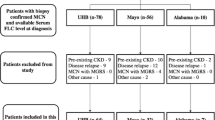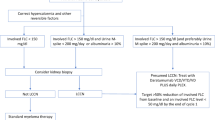Abstract
We retrospectively reviewed 49 patients with light chain (LC) Fanconi syndrome (FS). Patients presented with chronic kidney disease (median estimated glomerular filtration rate (eGFR) of 33 ml/min/1.73 m2) and tubular proteinuria. All patients tested had elevated fractional excretion of phosphate, uric acid, generalized aminoaciduria and/or normoglycemic glycosuria. Thirty-eight patients had monoclonal gammopathy of renal significance and eleven patients had an overt hematological malignancy. The monoclonal LC isotype was kappa in 46/49 cases. Kidney biopsy in 39 patients showed various proximal tubular lesions and characteristic LC intracytoplasmic crystalline inclusions in 24 patients. Forty-two patients received chemotherapy. Patients with plasma cell proliferation (n=38) received bortezomib-based regimens (n=11), immunomodulatory agents (n=7) or alkylating agents (n=6). High-dose melphalan (HDM) followed by autologous stem cell transplantation was performed in 14 patients. Hematological response was obtained in 90% of evaluable patients, assessed on serum free light chains (FLC). GFR remained stable as long as hematological response was maintained and declined when serum FLC level rebounded. Improvement in proximal tubule function occurred in 13 patients. In patients with LC-associated FS, chemotherapy using HDM and/or new generation anti-myeloma agents can stabilize renal function and improve proximal tubule function. Serum FLC should be used to assess the hematological response, related to renal outcome.
This is a preview of subscription content, access via your institution
Access options
Subscribe to this journal
Receive 12 print issues and online access
$259.00 per year
only $21.58 per issue
Buy this article
- Purchase on Springer Link
- Instant access to full article PDF
Prices may be subject to local taxes which are calculated during checkout




Similar content being viewed by others
References
Maldonado JE, Velosa JA, Kyle RA, Wagoner RD, Holley KE, Salassa RM . Fanconi syndrome in adults. A manifestation of a latent form of myeloma. Am J Med 1975; 58: 354–364.
Messiaen T, Deret S, Mougenot B, Bridoux F, Dequiedt P, Dion JJ et al. Adult Fanconi syndrome secondary to light chain gammopathy. Clinicopathologic heterogeneity and unusual features in 11 patients. Medicine (Baltimore) 2000; 79: 135–154.
Leung N, Bridoux F, Hutchison CA, Nasr SH, Cockwell P, Fermand J-P et al. Monoclonal gammopathy of renal significance: when MGUS is no longer undetermined or insignificant. Blood 2012; 120: 4292–4295.
Fermand J-P, Bridoux F, Kyle RA, Kastritis E, Weiss BM, Cook MA et al. How I treat monoclonal gammopathy of renal significance (MGRS). Blood 2013; 122: 3583–3590.
Ma CX, Lacy MQ, Rompala JF, Dispenzieri A, Rajkumar SV, Greipp PR et al. Acquired Fanconi syndrome is an indolent disorder in the absence of overt multiple myeloma. Blood 2004; 104: 40–42.
Stokes MB, Valeri AM, Herlitz L, Khan AM, Siegel DS, Markowitz GS et al. Light chain proximal tubulopathy: clinical and pathologic characteristics in the modern treatment era. J Am Soc Nephrol JASN 2016; 27: 1555–1565.
Bridoux F, Leung N, Hutchison CA, Touchard G, Sethi S, Fermand J-P et al. Diagnosis of monoclonal gammopathy of renal significance. Kidney Int 2015; 87: 698–711.
Palladini G, Dispenzieri A, Gertz MA, Kumar S, Wechalekar A, Hawkins PN et al. New criteria for response to treatment in immunoglobulin light chain amyloidosis based on free light chain measurement and cardiac biomarkers: impact on survival outcomes. J Clin Oncol 2012; 30: 4541–4549.
Levey AS, Bosch JP, Lewis JB, Greene T, Rogers N, Roth D . A more accurate method to estimate glomerular filtration rate from serum creatinine: a new prediction equation. Modification of Diet in Renal Disease Study Group. Ann Intern Med 1999; 130: 461–470.
El Hamel C, Thierry A, Trouillas P, Bridoux F, Carrion C, Quellard N et al. Crystal-storing histiocytosis with renal Fanconi syndrome: pathological and molecular characteristics compared with classical myeloma-associated Fanconi syndrome. Nephrol Dial Transplant 2010; 25: 2982–2990.
Bridoux F, Sirac C, Hugue V, Decourt C, Thierry A, Quellard N et al. Fanconi’s syndrome induced by a monoclonal Vκ3 light chain in Waldenström’s macroglobulinemia. Am J Kidney Dis 2005; 45: 749–757.
Narvaez J, Domingo-Domenech E, Narvaez JA, Nolla JM, Valverde J . Acquired hypophosphatemic osteomalacia associated with multiple myeloma. Jt Bone Spine Rev Rheum 2005; 72: 424–426.
Bate KL, Clouston D, Packham D, Ratnaike S, Ebeling PR . Lambda light chain induced nephropathy: a rare cause of the Fanconi syndrome and severe osteomalacia. Am J Kidney Dis 1998; 32: E3.
Sirac C, Bridoux F, Essig M, Devuyst O, Touchard G, Cogné M . Toward understanding renal Fanconi syndrome: step by step advances through experimental models. Contrib Nephrol 2011; 169: 247–261.
Sirac C, Bridoux F, Carrion C, Devuyst O, Fernandez B, Goujon J-M et al. Role of the monoclonal kappa chain V domain and reversibility of renal damage in a transgenic model of acquired Fanconi syndrome. Blood 2006; 108: 536–543.
Leboulleux M, Lelongt B, Mougenot B, Touchard G, Makdassi R, Rocca et al. Protease resistance and binding of Ig light chains in myeloma-associated tubulopathies. Kidney Int 1995; 48: 72–79.
Larsen CP, Bell JM, Harris AA, Messias NC, Wang YH, Walker PD . The morphologic spectrum and clinical significance of light chain proximal tubulopathy with and without crystal formation. Mod Pathol 2011; 24: 1462–1469.
Gu X, Barrios R, Cartwright J, Font RL, Truong L, Herrera GA . Light chain crystal deposition as a manifestation of plasma cell dyscrasias: the role of immunoelectron microscopy. Hum Pathol 2003; 34: 270–277.
Herrera GA . Proximal tubulopathies associated with monoclonal light chains: the spectrum of clinicopathologic manifestations and molecular pathogenesis. Arch Pathol Lab Med 2014; 138: 1365–1380.
Nasr SH, Galgano SJ, Markowitz GS, Stokes MB, D’Agati VD . Immunofluorescence on pronase-digested paraffin sections: a valuable salvage technique for renal biopsies. Kidney Int 2006; 70: 2148–2151.
Fogo AB, Lusco MA, Najafian B, Alpers CE . AJKD atlas of renal pathology: light chain proximal tubulopathy. Am J Kidney Dis 2016; 67: e9–e10.
Elliott MR, Cortese C, Moreno-Aspitia A, Dwyer JP . Plasma cell dyscrasia causing light chain tubulopathy without Fanconi syndrome. Am J Kidney Dis 2010; 55: 1136–1141.
Said SM, Assaad AM, Cerda J, Nasr SH . Light chain tubulopathy without Fanconi syndrome. Nephrol Dial Transplant 2006; 21: 3589–3590.
Figueres M-L, Beaume J, Vuiblet V, Rabant M, Bassilios N, Herody M et al. Crystalline light chain proximal tubulopathy with chronic renal failure and silicone gel breast implants: 1 case report. Hum Pathol 2015; 46: 165–168.
Leung N, Nasr SH . Myeloma-related kidney disease. Adv Chronic Kidney Dis 2014; 21: 36–47.
Stokes MB, Aronoff B, Siegel D, D’Agati VD . Dysproteinemia-related nephropathy associated with crystal-storing histiocytosis. Kidney Int 2006; 70: 597–602.
Chauvet S, Bridoux F, Ecotière L, Javaugue V, Sirac C, Arnulf B et al. Kidney diseases associated with monoclonal immunoglobulin M-secreting B-cell lymphoproliferative disorders: a case series of 35 patients. Am J Kidney Dis 2015; 66: 756–767.
Duquesne A, Werbrouck A, Fabiani B, Denoyer A, Cervera P, Verpont MC et al. Complete remission of monoclonal gammopathy with ocular and periorbital crystal storing histiocytosis and Fanconi syndrome. Hum Pathol 2013; 44: 927–933.
Nishida Y, Iwama K, Yamakura M, Takeuchi M, Matsue K . Renal Fanconi syndrome as a cause of chronic kidney disease in patients with monoclonal gammopathy of undetermined significance: partially reversed renal function by high-dose dexamethasone with bortezomib. Leuk Lymphoma 2012; 53: 1804–1806.
Author information
Authors and Affiliations
Corresponding author
Ethics declarations
Competing interests
The authors declare no conflict of interest.
Rights and permissions
About this article
Cite this article
Vignon, M., Javaugue, V., Alexander, M. et al. Current anti-myeloma therapies in renal manifestations of monoclonal light chain-associated Fanconi syndrome: a retrospective series of 49 patients. Leukemia 31, 123–129 (2017). https://doi.org/10.1038/leu.2016.195
Received:
Revised:
Accepted:
Published:
Issue Date:
DOI: https://doi.org/10.1038/leu.2016.195
This article is cited by
-
Lambda light chain-induced monoclonal gammopathy of renal significance, manifesting with Fanconi Syndrome and osteomalacia
BMC Nephrology (2022)
-
Clinicopathologic characteristics and prognostic analysis of monoclonal gammopathy of renal significance (MGRS) in patients with IgM monoclonal gammopathy: a case series
Scientific Reports (2022)
-
Crystalline deposits in the cornea and various areas of the kidney as symptoms of an underlying monoclonal gammopathy: a case report
BMC Nephrology (2021)
-
Kidney injury and disease in patients with haematological malignancies
Nature Reviews Nephrology (2021)
-
The Causes of Hypo- and Hyperphosphatemia in Humans
Calcified Tissue International (2021)



